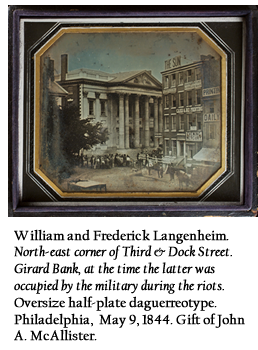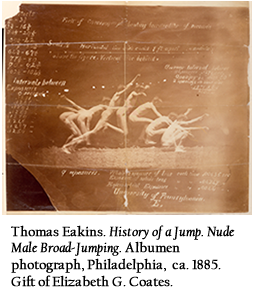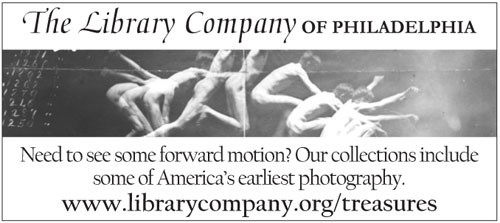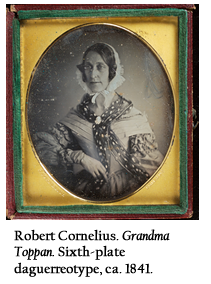Treasures from the Library Company of Philadelphia: Photograph Collection
Treasures from the Library Company of Philadelphia: Photograph Collection
The Library Company of Philadelphia’s photograph collection focuses on work by Philadelphia photographers and on views of the city, but even within those parameters our holdings include works of national significance. Philadelphia played an important role in the introduction of photography to America and throughout the 19th century many of the country’s leading photographers worked in Philadelphia studios.
In August 1839 Louis-Jacques Mandé Daguerre publicly announced to a French audience his success in taking a photographic image on a metal plate and word of this amazing discovery spread quickly across the Atlantic. Within two months, Philadelphian Joseph Saxton had succeeded in making a daguerreotype of the city’s Central High School following Daguerre’s instructions. Philadelphia’s learned societies including the American Philosophical Society and the Franklin Institute became fertile grounds for the exchange of ideas about how to improve the daguerreotype process. Technological advances such as the lessening of exposure times paved the way for the city’s first commercial daguerreotype studio to open its doors in May 1840. Established by Robert Cornelius, sitters could have their portraits taken for $5.00. The Library Company’s holdings include six portraits taken by Cornelius during the very beginnings of photography including this image of a woman known to us only as Grandma Toppan. Many of our daguerreotype treasures, as well as a few stunning examples from other local institutions, were featured in our 2009 exhibition Catching A Shadow: Daguerreotypes in Philadelphia, 1839-1860, now available online.
 Cornelius remained in business for less than two years, but photography continued to flourish in the city. By the mid-1850s, approximately 100 studios were in business including that of the brothers William and Frederick Langenheim. While the vast majority of daguerreotypes were studio portraits, the Langenheim brothers were also willing to venture out of their studio. They gained an international reputation with their daguerreotypes taken at Niagara Falls in 1845, sets of which were sent to European heads of states and Louis Daguerre. In the daguerreotype illustrated here, the Langenheims have turned their camera to what was happening directly outside their studio window and, in essence, have captured America’s first news photograph. Through the camera lens we see the Pennsylvania militia on May 6, 1844 gathering outside the First Bank of the United States to quell Philadelphia’s anti-Catholic riots.
Cornelius remained in business for less than two years, but photography continued to flourish in the city. By the mid-1850s, approximately 100 studios were in business including that of the brothers William and Frederick Langenheim. While the vast majority of daguerreotypes were studio portraits, the Langenheim brothers were also willing to venture out of their studio. They gained an international reputation with their daguerreotypes taken at Niagara Falls in 1845, sets of which were sent to European heads of states and Louis Daguerre. In the daguerreotype illustrated here, the Langenheims have turned their camera to what was happening directly outside their studio window and, in essence, have captured America’s first news photograph. Through the camera lens we see the Pennsylvania militia on May 6, 1844 gathering outside the First Bank of the United States to quell Philadelphia’s anti-Catholic riots.
 Throughout their long careers, the Langenheims experimented with different photographic formats and processes and were one of the Philadelphia studios that successfully made the transition during the late 1850s from daguerreotypes to paper photography. Experimentation was still the hallmark of photographic progress thirty years after this transition when artist Thomas Eakins attempted to photographically capture the movement of nude models as they ran, jumped, and pole vaulted in a secluded area at the University of Pennsylvania. Eakins initially worked with Eadweard Muybridge who had successfully photographed animal locomotion, but grew dissatisfied with Muybridge’s reliance on a bank of cameras snapping images as the subject passed each camera. Eakins instead made modifications to Etienne-Jules Marey’s slotted wheel that spun rapidly in front of a single camera lens as that camera took photographs. Using a modified Marey wheel, Eakins took the photograph illustrated here of a young man jumping and wrote extensive notes on the negative detailing the intervals between each exposure.
Throughout their long careers, the Langenheims experimented with different photographic formats and processes and were one of the Philadelphia studios that successfully made the transition during the late 1850s from daguerreotypes to paper photography. Experimentation was still the hallmark of photographic progress thirty years after this transition when artist Thomas Eakins attempted to photographically capture the movement of nude models as they ran, jumped, and pole vaulted in a secluded area at the University of Pennsylvania. Eakins initially worked with Eadweard Muybridge who had successfully photographed animal locomotion, but grew dissatisfied with Muybridge’s reliance on a bank of cameras snapping images as the subject passed each camera. Eakins instead made modifications to Etienne-Jules Marey’s slotted wheel that spun rapidly in front of a single camera lens as that camera took photographs. Using a modified Marey wheel, Eakins took the photograph illustrated here of a young man jumping and wrote extensive notes on the negative detailing the intervals between each exposure.
Many of the Library Company’s most important photographic collections have been digitized and are available through our digital catalog.
View the Entire Treasures Online Exhibition Series Here: http://www.librarycompany.org/treasures/





Leave a Reply
Want to join the discussion?Feel free to contribute!